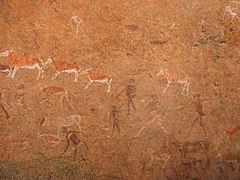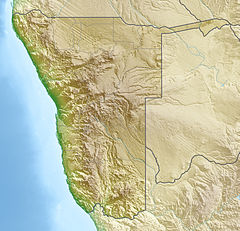The White Lady is a rock painting, located on a panel, which also displays other art work. The paintings can be found on a small rock overhang, deep within Brandberg Mountain. The giant granite monolith located in Damaraland and called 'The Brandberg' is Namibia's highest mountain. The painting's German name is Weiße Dame.
 White Lady, visible in the lower right corner | |
| Alternative name | Weiße Dame |
|---|---|
| Location | Brandberg Mountain, Damaraland |
| Region | Namibia |
| Coordinates | 21°06′38″S 14°39′46″E / 21.11056°S 14.66278°E |
| Site notes | |
| Excavation dates | 1929 |
| Archaeologists | Reinhard Maack |


The painting has long been an archaeological dilemma, and several different hypotheses have been put forth on its origins, authorship and dating. It is now usually accepted to be a bushmen painting,[1] dating back to at least 2000 years.[2]
Location and description
editThe "White Lady" archaeological site is located close to the road from Khorixas to Henties Bay, in the area of Uis, on the Brandberg Massif. The Brandberg itself hosts over 1.000 bushmen paintings, scattered across rock shelters and caves.[3]
The "White Lady Group" is found in a cave known as "Maack Shelter"[i] and portrays several human figures as well as oryxes, on a rock panel measuring about 5.5 m x 1.5 m. The "White Lady" is the most detailed human figure in the group, and measures about 39.5 cm x 29 cm. To reach The White Lady it is necessary to hike for about 45–60 minutes over rough terrain, along the gorge of the normally dry Tsisab river.
It is usually assumed that the painting shows some sort of ritual dance, and that the "White Lady" is a shaman. She has white legs and arms, which may suggest that her body was painted or that she was wearing some sort of decorative attachments on her legs and arms. She holds a bow in one hand and perhaps a goblet in the other. Because of the bow and the oryxes, the painting has also been interpreted as a hunting scene. Apart from the shaman/lady, the other human figures have less detail, and are mostly completely black or completely white. One of the oryxes has human legs. The paint was probably made of ochre, charcoal, manganese, hematite with blood serum, egg white and casein used as binding agents.[3]
The painting has undergone severe damage since it was first discovered in the early 20th century. For a few decades, tourists would pour water onto the painting to make the colors more clearly visible, causing the painting to fade quickly. The site is now a protected heritage site of Namibia and visiting is only permitted with official guides. For protection of the art works, bags and bottles are not allowed at the far end of the trail.
Because of tourist protests, the metal wire netting has been replaced by only two metal bars, to ensure a better view.
Finding and interpretation controversy
editThe White Lady was first discovered in 1918 by German explorer and topographer Reinhard Maack. As he was surveying the Brandberg. Maack was impressed by the main figure of the painting, which he described as "a warrior". In his notes, he wrote that "the Egyptian-Mediterranean style of all the figures is surprising". He made several hand-drawn copies of the painting, which were later published in Europe.[3]
In 1929, Maack's notes came under the attention of the well-known French anthropologist Henri Breuil while he was visiting Cape Town. Breuil noted analogies between the White Lady and paintings of athletes found in Knossos (Crete), and suggested that the Brandberg might have been visited by a group of travelers coming from the Mediterranean area. It was Breuil who first referred to the painting as "the white lady". In 1945 Breuil could finally visit the White Lady site, and published his theories on the Mediterranean origin of the painting first in South Africa and then in Europe.[4]
Breuil's arguments influenced several later hypotheses concerning the painting, some which suggested that it could be Phoenician in origin. Breuil's farfetched theory aligned with the racist policies of the South African government at that time, which downplayed any evidence that Black people could produce sophisticated art works.
In the second half of the 20th century, most theories about Mediterranean influences on the ancient history of sub-Saharan Africa (like those about Great Zimbabwe being "non-African" in origin) were gradually dismissed.[5]
Notes
edit- ^ After its modern discoverer, the German explorer Reinhard Maack.
- ^ Hall, Martin (1996). Archaeology Africa. James Currey Publishers. pp. 214–215. ISBN 978-0-85255-735-8. Retrieved 19 February 2020.
- ^ Cowley, cap. 9
- ^ a b c Namibia 1 on 1
- ^ Breuil (1948) and Breuil (1955)
- ^ Davidson (1963)
References
edit- Henri Breuil, (1948) The White Lady of the Brandberg: Her Companions and Her Guards, «South African Archaeological Bulletin»
- Henri Breuil et al. (1955), The White Lady of the Brandberg. Faber & Faber, New York.
- Clive Cowley, Journey into Namibia ([1])
- Basil Davidson (1963), Old Africa Rediscovered.
- Credo Mutwa (1991), Indaba: La favolosa storia delle genti africane. Red.
- Namibia 1 on 1, The White Lady of the Brandberg ([2])
- Hugo Obermaier, Herbert Kühn: Buschmannkunst. Felsmalereien aus Südwestafrika. Schmidt & Gunther, Leipzig. (1930)[3]
